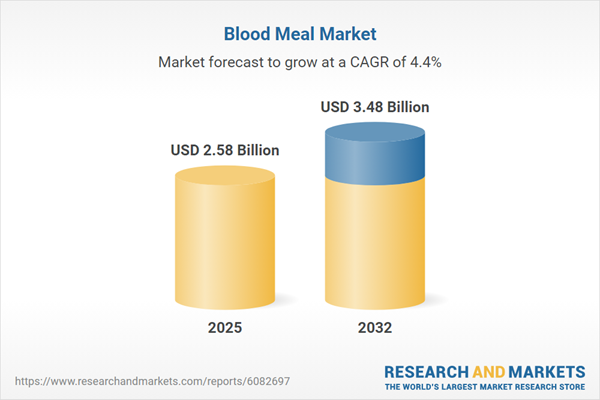Speak directly to the analyst to clarify any post sales queries you may have.
The blood meal market is being reshaped as sustainability imperatives, regulatory shifts, and advances in agricultural technology redefine operational priorities. Decision-makers are steering their organizations to achieve competitive agility while aligning with evolving industry standards.
Market Snapshot: Blood Meal Market Growth and Outlook
The blood meal market moved from USD 2.47 billion in 2024 to USD 2.58 billion in 2025 and is projected to attain USD 3.48 billion by 2032, demonstrating a CAGR of 4.36%. Ongoing growth is fueled by higher demand for sustainable and organic agricultural solutions. Both manufacturers and end users are investing in improved sourcing and processing models to meet new operational and ecological standards, prompting enhanced decision-making across the value chain.
Scope & Segmentation: Comprehensive Coverage of the Blood Meal Market
- End User: Commercial-scale agricultural producers and residential gardeners employ blood meal for targeted nutrient management and soil health improvement, underscoring the broad application range across farms and households.
- Distribution Channel: Hypermarkets, supermarkets, specialty stores, and an expanding online landscape give buyers flexible options, responding to the trend toward omnichannel sourcing for both high-volume and individual orders.
- Product Type: Offerings span from crude to purified blood meal, providing tailored solutions that fit performance criteria and budget considerations for various buyer profiles.
- Application: Primarily utilized as an organic fertilizer and soil amendment, blood meal offers agronomic advantages in plant vitality and yield, reinforcing its relevance for both intensive and precision farming.
- Form: Available as granules and powder, products serve both mechanized, large-acreage farms and smaller-scale or targeted applications, delivering versatile solutions to meet operational needs.
- Crop Type: Demand spans field crops, fruit and vegetable cultivation, turf, and ornamentals, positioning blood meal as a versatile nutrient source adaptable to various growing environments.
- Regions: The study includes North America, Latin America, Europe, Middle East, Africa, and Asia-Pacific, showcasing both mature and growth-stage agricultural economies that present unique regulatory and market access challenges.
- Company Profiles: Detailed analysis is provided for leading players, including Darling Ingredients Inc., JBS S.A., Tyson Foods, Inc., Valley Proteins, Inc., West Coast Reduction Ltd., MidAmerica Proteins, Inc., Vion Food Group, Sanimax Group Inc., Hong Kong Rendering (Holdings) Limited, and Harwich Animal Feeds Limited, highlighting each firm’s strategic position and competitive approach within the sector.
Key Takeaways: Strategic Insights for Senior Decision-Makers
- Sustainability initiatives and organic certification protocols are expanding the role of blood meal within modern soil health strategies, making regulatory compliance a strategic differentiator.
- Innovations in processing support consistent product quality, appealing to professional growers and specialty crop producers seeking value-added solutions and reliability in agricultural inputs.
- Digital agriculture tools, such as soil sensors and real-time monitoring, enable users to optimize nutrient application and ensure end-to-end traceability, supporting data-driven production planning.
- Collaborative partnerships between established agribusinesses and niche firms are opening access to diverse customer groups and enhancing distribution agility through shared expertise and expanded processing assets.
- Traceability advancements, including adoption of blockchain-enabled recordkeeping, help address transparency goals and regulatory requirements, enhancing trust in product quality and origins for downstream buyers.
- Widespread adoption across commercial, specialized, and residential segments indicates a market that is responsive to varied application needs and evolving demand for convenience and measurable outcomes.
Tariff Impact: Assessing United States Tariff Impacts on Trade and Pricing
Recent shifts in United States tariff regulations have patterning global blood meal trade flows and influencing supplier pricing strategies. In response, importers are adapting procurement methods, reevaluating geographic sourcing, and considering vertical integration to manage tariff exposure. These developments are fostering intensified competition among suppliers, reshaping value-added processing approaches, and driving innovation in supply stability measures and partnership models across multiple regions.
Research Methodology & Data Sources
This study utilized comprehensive primary research through expert interviews and secondary analysis, leveraging trade databases, regulatory documents, and academic literature. Quantitative findings were validated through recognized analytical models, including SWOT and PESTEL frameworks, ensuring robust triangulation and reliable insights for strategic planning.
Why This Report Matters
- Delivers actionable intelligence for executives aiming to strengthen product positioning and operational efficiency within the global blood meal market.
- Reveals critical segment and purchasing trends, supporting strategic expansion and investment decisions that align with shifting user behaviors and regulatory settings.
- Equips leaders to anticipate shifts in supply chains, regulatory frameworks, and technological innovation, enabling strategic planning and proactive risk management.
Conclusion
Senior stakeholders who integrate innovation, regulatory awareness, and resilient supply chain strategies will be well-positioned as the blood meal market continues to evolve. Ongoing adaptation and market monitoring are essential for sustained value creation.
Table of Contents
3. Executive Summary
4. Market Overview
7. Cumulative Impact of Artificial Intelligence 2025
Companies Mentioned
The companies profiled in this Blood Meal market report include:- Darling Ingredients Inc.
- JBS S.A.
- Tyson Foods, Inc.
- Valley Proteins, Inc.
- West Coast Reduction Ltd.
- MidAmerica Proteins, Inc.
- Vion Food Group
- Sanimax Group Inc.
- Hong Kong Rendering (Holdings) Limited
- Harwich Animal Feeds Limited
Table Information
| Report Attribute | Details |
|---|---|
| No. of Pages | 187 |
| Published | November 2025 |
| Forecast Period | 2025 - 2032 |
| Estimated Market Value ( USD | $ 2.58 Billion |
| Forecasted Market Value ( USD | $ 3.48 Billion |
| Compound Annual Growth Rate | 4.3% |
| Regions Covered | Global |
| No. of Companies Mentioned | 11 |









